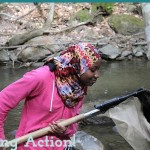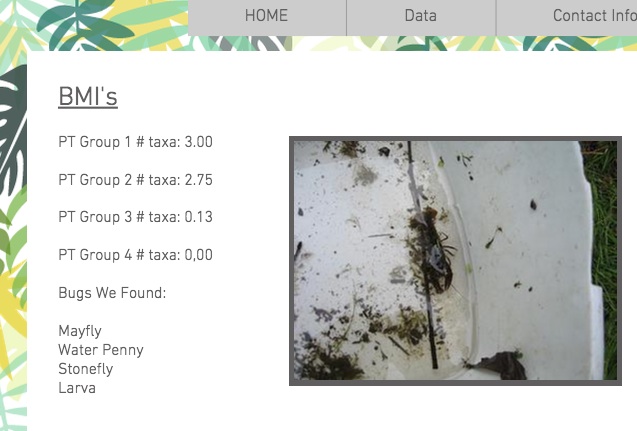Students partner with local scientists in collecting, analyzing & disseminating water data
 A group of 7th and 8th grade students took a trip through the full cycle of scientific study this past year. Edmunds Middle School students partnered with the UVM Watershed Alliance to study the Lake Champlain Direct and Grand Isles Basins, very specifically, the Potash Brook that runs close by the school.
A group of 7th and 8th grade students took a trip through the full cycle of scientific study this past year. Edmunds Middle School students partnered with the UVM Watershed Alliance to study the Lake Champlain Direct and Grand Isles Basins, very specifically, the Potash Brook that runs close by the school.
At the conclusion of the project, they presented the outcome of their studies in a variety of different ways, leveraging online tools to maximize the impact of their dissemination.
Watershed study program gives students hands-on scientific practice
The UVM Watershed Alliance partners with a variety of local schools to create watershed study programs specific to the area in which the school is located. In this particular case:
Students engaged in a unique Watershed Alliance program titled the “Burlington Bio Blitz”. During the program, students observed the topographic landscape, assessed soil for its composition, and examined the surrounding forest in along the Potash Brook in Burlington, Vermont. The objective of this program was to engage students in hands-on activities that helped them to better understand the context in which the Potash Brook Watershed exists, be it urban, suburban or forested.
During the program, students began by getting a demonstration of the watershed concept, then they received a demonstration of the equipment and data collection method, and were introduced to watershed and water quality monitoring methods.

The instructional methods discussed include habitat assessment, chemical monitoring and benthic macroinvertebrate sampling. Finally, students received training on outreach and stewardship, with an emphasis on unbiased scientific reporting. Check out the full contents of the program here.
Edmunds has participated in the UVM Watershed Alliance program for the past five years, according to program coordinator Erin De Vries. This has allowed the school to build up enough data about the Potash Brook to talk about longitudinal changes to the watershed, as well as uploading new data sets to an online database and interactive map of watersheds in Vermont. At the conclusion of each year of study, students present their findings to their peers, the UVM Watershed Alliance instructors and concerned community groups.
But how can student-collected scientific data make an impact?
Learning how to collect and analyze watershed data gives students insight into what it’s like to work in the water sciences field, but an equally important part of the process is learning how to package up that data to share with the rest of the community. What are some ways that data can be made consumable with web 2.0 tools?
Students Jamin and Elliott packaged up their data into the water science news report, above, harnessing the allure of video to share their findings. Other students created websites with tips for reducing water pollution, a self-paced water quality assessment tool, and a Google presentation that the UVM Watershed Alliance uses to showcase the project on their own website.
One pair of students even expanded their data collection efforts by including a short survey about the data on their website.
What We Like About All This
This topic and these projects supported students as they made concrete connections from the curriculum to their own environment. Additionally, the topic of water quality in our streams, rivers, and lakes has been all over the news here in Vermont since our governor made it s center point during his inaugural address in January. The students at Edmunds recognized that state lawmakers were interested in the same issues, and made the real-world connections to their classroom.

These projects are also in alignment with the Next Generation Science Standards. Particularly, by investigating the watershed, they were able to see the interdependent relationships in ecosystems as well as the human impacts on the ecosystem. These standards areas are especially important to middle grades learners as they are defining their place and role in their own environment.
But don’t just take our word for it…
Check out the full roster of projects produced by these middle school students:
- Lake Trout Twitter Page
- Awesome Potash Brook Presentation
- Cenia’s Brochure
- Keeping Lake Champlain Healthy Website
- Watershed Website
- Galen & Lily Watershed Website
- Maia & Mary- Watershed Website
- Jake’s Watershed Website
- Julius and Avery’s Watershed Presentation
- Kofi’s Potash Brook Info Multi-Page Flyer
- Isabel & Summer’s Watershed Info website
- Owen and Jensen’s Website
- Anders & Milano’s Website
- William’s Watershed Website
- Mason and Aidan’s Awesomest Watershed Link
- Alexis and Skylar’s Watershed Website link <3
- Is your stream healthy
- Miles and Henry Project
- Avena and Ellie Watershed
- Jamin and Elliott Video
- Cheyenne How to keep VT waters clean
- Emily and Annabelle Erosion in Lake Champlain
- Chitsa & Dadir Keep it clean
- Cassandra and Nya Water Outreach Poster
- Lennon & Kolby Watershed Project
- Famo-Watershed Project
- Fern’s Brochure Front and Back
And in this video, some Vermont educators provide their perspective on participating in this program.
Interested in partnering with the UVM Watershed Alliance?
For more information about partnering with the UVM Watershed Alliance, check out how to apply for the program, as well as a list of all the schools they’ve partnered with. They program is in its 15th year and is currently looking for new schools and teachers to partner with.


Interpreting watershed science data http://t.co/fdH1qGTFZl http://t.co/J6SJXyhERT http://t.co/rcFpuDMvir
Making a difference with watershed science data – project based learning! Connections to community! http://t.co/qK2a2JLY47 via @innovativeEd
RT @mwolofson: Making a difference with watershed science data – project based learning! Connections to community! http://t.co/qK2a2JLY47 v…
Middle school Ss partner with @UVMExtension program to study, disseminate data on local watershed http://t.co/14SUlH9hxP #vted
Great program for Cortina this past Spring…. Making a difference with watershed science data http://t.co/IZ6r9lwqMG
RT @innovativeEd: Middle school Ss partner with @UVMExtension program to study, disseminate data on local watershed http://t.co/14SUlH9hxP …